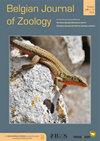Biodiversity and seasonal variations of zooneuston in the northwestern Mediterranean Sea
IF 1.1
4区 生物学
Q2 ZOOLOGY
引用次数: 3
Abstract
Neuston includes animals and plants inhabiting the surface layer of the water column. The neustonic area is an accumulation zone for bacteria, organic molecules but also terrestrial debris. The surface layer is also the air/water exchange region. Therefore, neustonic organisms are directly exposed to several constraints such as wind stress and turbulence. The present study aims to characterize the zooneuston in terms of abundance and biodiversity and to evaluate the impacts of wind stress on neustonic abundance. Zooneustonic and zooplanktonic (depth of 5 meters) samples were collected twice a month between 30th August 2011 and 10th July 2012 in Calvi Bay, Corsica. Zooneustonic biodiversity was high and, notably, twenty-eight copepod genera were identified. Among these copepods, several organisms, belonging to the Pontellidae family, were much more frequent in neuston than in underlying plankton and their abundance depended on wind direction. Taxon-specific trends in seasonal abundance variation were present. For example, individuals of the Acantharia Lithoptera spp. were found in summer whereas the Pontellidae Anomalocera patersoni appeared in winter. Overall, our data provide a first step towards a better knowledge of neuston community structure in the Mediterranean Sea.地中海西北部动物栖生物的生物多样性和季节变化
Neuston包括栖息在水柱表层的动物和植物。neustonic区域是细菌、有机分子以及陆地碎片的聚集区。表面层也是空气/水交换区域。因此,neustonic生物体直接暴露在风应力和湍流等多种约束条件下。本研究旨在从丰度和生物多样性方面描述人畜共患动物的特征,并评估风应力对动物丰度的影响。2011年8月30日至2012年7月10日期间,在科西嘉岛卡尔维湾每月采集两次动物和浮游动物(深度5米)样本。动物的生物多样性很高,值得注意的是,已经鉴定出28个桡足类属。在这些桡足类中,有几种属于庞氏科的生物在纽斯顿比底层浮游生物更常见,它们的丰度取决于风向。紫杉醇在季节丰度变化方面呈现出特定的趋势。例如,在夏季发现了Acantharia Lithoptera spp.的个体,而在冬季发现了Pontellidae Anomalocera patersoni。总的来说,我们的数据为更好地了解地中海的纽斯顿社区结构迈出了第一步。
本文章由计算机程序翻译,如有差异,请以英文原文为准。
求助全文
约1分钟内获得全文
求助全文
来源期刊

Belgian Journal of Zoology
生物-动物学
CiteScore
1.90
自引率
0.00%
发文量
10
审稿时长
>12 weeks
期刊介绍:
The Belgian Journal of Zoology is an open access journal publishing high-quality research papers in English that are original, of broad interest and hypothesis-driven. Manuscripts on all aspects of zoology are considered, including anatomy, behaviour, developmental biology, ecology, evolution, genetics, genomics and physiology. Manuscripts on veterinary topics are outside of the journal’s scope. The Belgian Journal of Zoology also welcomes reviews, especially from complex or poorly understood research fields in zoology. The Belgian Journal of Zoology does no longer publish purely taxonomic papers. Surveys and reports on novel or invasive animal species for Belgium are considered only if sufficient new biological or biogeographic information is included.
 求助内容:
求助内容: 应助结果提醒方式:
应助结果提醒方式:


